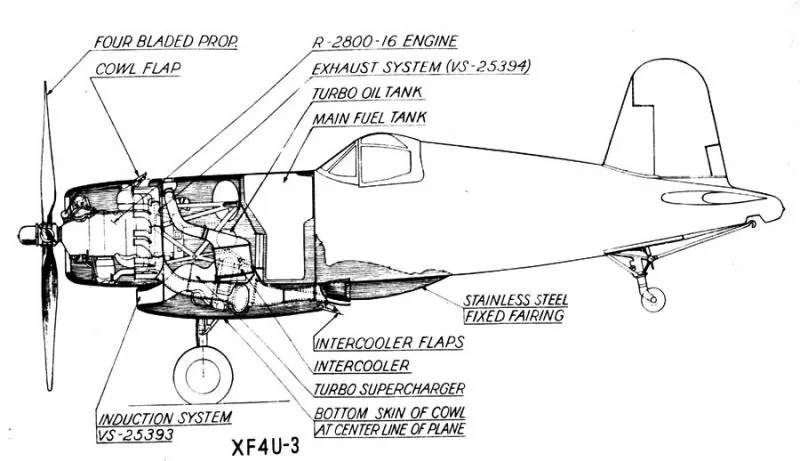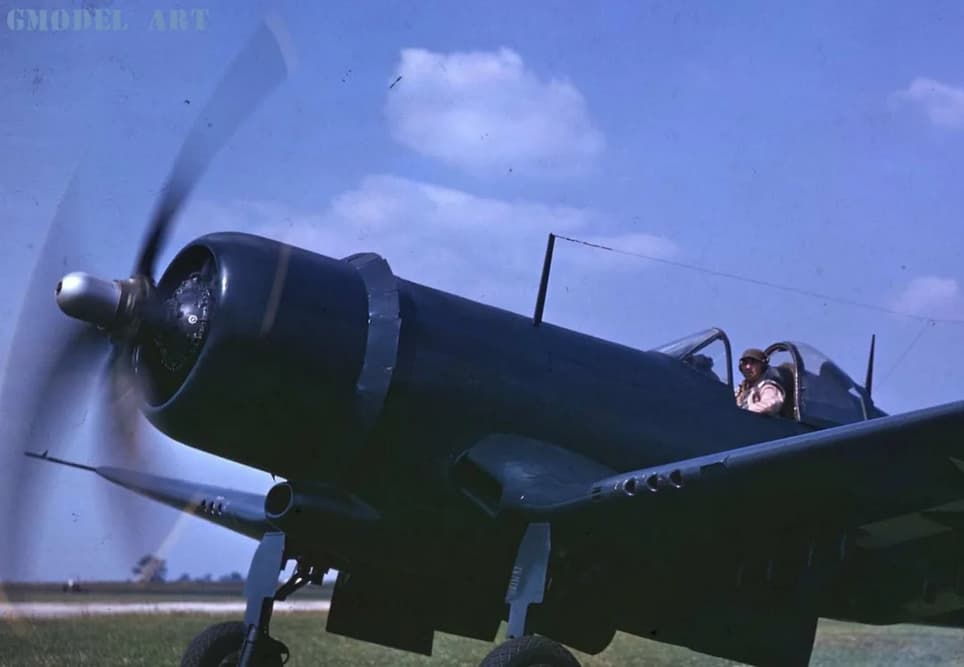- Yes
- No
Hello everybody. I’d like to suggest the Goodyear FG-3 Corsair for US aviation in War Thunder. It was based on an FG-1D airframe converted to the XF4U-3B standard and modified to carry a more powerful engine with a turbo-supercharger and a four-bladed propeller. It was developed for the US Marine Corps with an extreme high-altitude fighting capability; however, it never officially entered production, as the F4U-4 proved superior in low altitude and had similar performance in middle-to-high altitudes.
Key Characteristics
- High-altitude naval fighter
- Based on a FG-1D airframe
- 2,600-hp Pratt & Whitney R-2800-14W + water injection for up to 6 minutes
- Turbo-supercharger in scoop-type air intake at the bottom of the engine
- 6 x .50-cal. machine guns + bombs + rockets.
History
The development of Vought XF4U-3/Goodyear FG-3 began on June 14, 1941, when the Bureau of Aeronautics requested Vought to submit a proposal for an improved high-altitude Corsair fitted with a new, two-stage Birmann-type turbo-supercharger. The goal was to make the F4U-3/FG-3 a high-speed and high-altitude version of the Corsair. It was predicted that the turbo-supercharger would improve flight performance and maneuverability at higher altitudes of 40,000 feet.
The Vought submitted proposal VS-331, and, in March 1942, the US Navy accepted the proposal and awarded Vought a contract for conversions of two F4U-1As modified with the larger, more powerful Pratt & Whitney XR-2800-16 engine and turbo-supercharger. This engine required the installation of a four-blade Hamilton-Standard propeller to handle larger torque generated by additional thrust.
The prototype was constructed and designated XF4U-3A. It was the converted F4U-1 (BuNo. 17516) with a birdcage canopy. It was painted in a standard Navy tricolor scheme with an Insignia Red engine cowling ring. The turbo-supercharged was installed in a large fairing under the fuselage. The scoop was located below the engine and the cowl flaps. The fairing was a structure that produced a smooth outline and reduced drag. This fairing of the aircraft was so large that it required the elimination of the catapult hook. This catapult hook was not the primary concern, as the proposed F4U-3/FG-3 was to be used exclusively by the Marines as a land-based fighter.
The other prototype was constructed and designated XF4U-3B. It was the converted F4U-1A (BuNo. 49664) with a redesigned engine to accommodate the R-2800-14W engine and turbo-supercharger instead of the XR-2800-16 due to development problems. A water injection system was also installed in the outer wing panel tank for a water reservoir. It had a Navy glossy sea blue scheme with an Insignia Red engine cowling ring. Like the XF4U-3A, the XF4U-3B eliminated the catapult hook.
In December 1942, the Bureau of Aeronautics requested a third XF4U-3 designated as an XF4U-3C, converted from a F4U-1 (BuNo. 02157) airframe; however, this aircraft was crashed at Stratford, California, and was stricken out from the project.
The installation of the Birmann turbo-supercharger added over 300 pounds to the weight of each Corsair; regardless, the prototypes were ready for the flight trials. The prototype (17516) flew for the first time on March 26, 1944, and the second prototype (49664) flew for the first time on September 20, 1944. According to the sources, the turbo-supercharged engine proved successful, and the XF4U-3s could attain a top speed of 414 mph at 25,000 feet and another top speed of 480 mph at 40,000 feet. The XF4U-3B could maintain the War Emergency Power of 2,600 hp from sea level up to 28,200 feet.
The original XF4U-3A flew for the last time on March 29, 1945, and was turned over to the Navy for further evaluation, while the XF4U-3B also followed the same destination on June 26, 1945.
Earlier in 1944, the Bureau of Aeronautics ordered Goodyear Aircraft Company to convert 26 FG-1Ds to XF4U-3B standards, each using the turbo-supercharger, but only 13 of these were completed and redesignated FG-3s. They were delivered to the Navy at Johnsville, California, between 3 and 7 July 1945. These aircraft were used only for high-altitude flight trials and further studies.
After the studies, it was concluded that the turbo-supercharged Corsair variant did not show any substantial improvement in performance over the F4U-4 at altitudes below 23,000 feet. Vought F4U-3 and Goodyear FG-3 never entered production, as the project was canceled for good. The issues with the turbo-supercharged R-2800 powerplant development and lacking the need for high-altitude performance in the Pacific contributed to the factors, including the F4U-4, that had led to the cancellation. The bottom line, it was a solution looking for a problem.
Had the project exceeded expectations, 100 F4U-3s/FG-3s would have been prepared and delivered to the US Marine Corps in the Pacific.
Specifications
Goodyear FG-3 CorsairGeneral Characteristics
- Crew: 1 (Pilot)
- Length: 33 ft 7.22 in (10.24 m)
- Height: 10 ft 11.5 in (3.34 m)
- Span: 40 ft 11.75 in (12.49 m)
- Wing area: 314 sq ft (29.2 sq m)
- Propeller Type: 4-bladed Hamilton Standard propeller
- Propeller Diameter: 13 ft 2 in (4.01 m)
- Powerplant: Pratt & Whitney R-2800-14W Double Wasp turbo-supercharged engine
→ 2,600 hp (1,939 kW)- Internal Fuel: 237 US gal. (897 L)
- Oil Tankage: 24 US gal. + 4 US gal. for turbo lubrication (90.8 L + 15.1 L)
- Empty Weight: 9,545 lb (4,329 kg)
- Gross Weight: 12,800 lb (5,806 kg)
Engine Ratings
Takeoff:
→ 2,100 BHP @ 2,800 RPM @ sea level
Combat:
→ 2,600 BHP @ 2,800 RPM @ sea level - 28,200 ft
Military:
→ 2,100 BHP @ 2,800 RPM @ sea level - 35,500 ft
Normal:
→ 1,700 BHP @ 2,600 RPM @ sea level - 37,800 ft
Performance @ Combat Power w/ Combat Loading Condition
- Power-to-Weight Ratio: 0.20 hp/lb (0.33 kW/kg)
- Sea Level Speed: 363 mph (584 km/h)
- Critical Altitude Speed: 460 mph @ 33,400 ft (740 km/h @ 10,180 m)
- Stall Speed Gross Weight: 89.7 mph (144 km/h)
- Stall Speed Without Fuel: 84.5 mph (136 km/h)
- Wing Loading: 40.7 lb/sq ft (198.7 kg/sq m)
- Take-off Distance - Calm: 584 ft (178 m)
- Rate of Climb at seal level: 4,210 fpm (21.4 m/s)
- Time to Altitude:
- 2.4 minutes to 10,000 ft (3,048 m)
- 5.0 minutes to 20,000 ft (6,096 m)
- Service Ceiling: 45,700 ft (13,929 m)
- Maximum Range: 1,080 - 1,575 miles (1,738 - 2,534 km)
Armament
- Guns:
- 6 x .50-cal. M2 Browning machine guns (2,400 rounds)
- Bombs:
- 2 x 1,600-lb armor-piercing bombs
- 2 x 1,000-lb bombs
- 2 x 500-lb bombs
- 2 x 250-lb bombs
- 6 x 100-lb bombs
- Rockets:
- 2 x 11.75-inch Tiny Tims
- 8 x 5-inch HVARs
- Drop Tanks:
- 2 x 150-gal drop tanks
Supplemental Data




Diagrams





XF4U-3A Images

XF4U-3B / FG-3 Images









Conclusion | Why it should be in the game
The FG-3 is an excellent opportunity to add as an event premium aircraft in War Thunder for US aviation. It was the fastest Corsair variant at the higher altitudes. The turbo-supercharger enabled the FG-3 to attain a higher speed of over 400 mph at 30,000 feet. This would make the aircraft the most potent high-altitude fighter to compete against Axis high-altitude fighters and interceptors. It would be an interesting aircraft to supplement with US low-altitude naval fighters and act as the transitional bridge from the F4U-1 to the F8F and FG-1.
- FG-3 Airplane Characteristics & Performance (1 July 1945)
- F4U Corsair in Action Aircraft Number 145 (1994)
- America’s Hundred Thousand: the U.S. Production Fighter Aircraft of World War II (1997)
- F4U Corsair in Detail and Scale Volume 55 Part 1: XF4U Through F2G (1998)
- Crowood Aviation Series Vought F4U Corsair (2002)
- https://www.jdsf4u.be/xf4u-3-vought-corsair
Thank you for taking the time to read my suggestion! 😃
